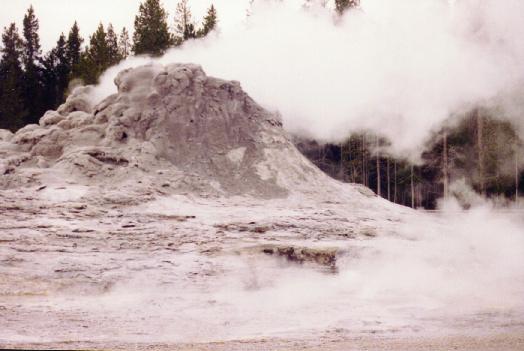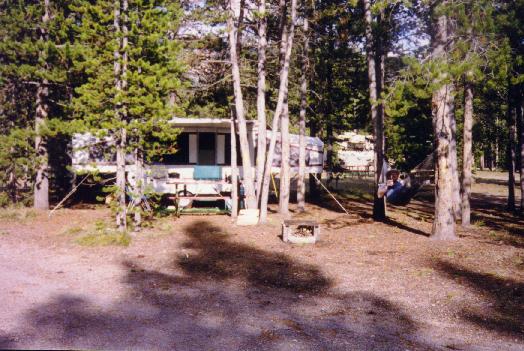Yellowstone National Park
Here are some of our best pictures from our brief visit to Yellowstone
National Park. The tourist season was just beginning, and we found out
why. It's still cold at this time of year, and there was still one road
closed because of snow. The advantage is that we didn't have much traffic
to fight.

You are now entering Yellowstone National Park in Wyoming.

This is June! We expected it to be cooler at the higher elevation
and lattitude, but we didn't expect deep snow drifts.

Old Faithful, the most famous geothermal feature in the park. There
are only three places on earth where these geothermal features can be observed,
and the largest is in Yellowstone National Park. Hot magma from deep
inside the earth is only about 5 miles below the surface. Ample surface
water from the melting snow seeps deep into the ground and is heated to
boiling temperature. The intense pressure inside the rock plumbing
keeps much of the water from actually boiling until it reaches atmospheric
pressure at the surface.

Old Faithful in full eruption. Thousands of gallons of steaming water
thunder into the sky reaching heights of 130 to 180 feet. The time
of the eruptions are difficult to gauge and are based on things like how
much water vented on the previous eruption and how violent the eruption
was. Old Faithful currently erupts an average of every 79 minutes.
We got to see it twice.

Castle Geyser is another geothermal feature not far from Old Faithful.
It has significant buildup from many thousands of years. Ancient
tree trunks are visible in the buildup. Old geysers have killed the
trees back for some distance around them, creating there own mini-dessert.

The primary geyser field extends for 1.5 miles. Many more geothermal
features are visible throughout much of the park.

So where does all that hot water go? Here Candi looks at the
runoff from a geyser field. The water runs into a nearby river.

A hot spring of boiling water. These pools in the geyser fields can
be very dangerous. As you can see in this photo, the crust surrounding
the pool is very thin, and people have broken through and fallen in.
Several people have been killed and many others severely scalded over the
years. To make matters worse, the springs bubble up from underground,
so what appears to be an open grassy area could be an invitation to disaster.
The park provides catwalks and sidewalks to keep visitors safe. Many
of the safety features were funded by a family that lost their nine-year-old
boy in the 1960's.

Morning Glory Pool gets its name because it looks like the flower.
The hot spring is used to be a very deep blue, but is getting greener over
the years because people throw coins and other items into the pool clogging
it up. As the clog gets bigger, the water temperature drops and algea
begins to grow where it was too hot before. Park rangers clean the
pool annually, but much of the damage has been done. It is now illegal
to throw coins or other items into the hot springs.

Our trip through Yellowstone, Wyoming and Colorado crossed the Continental
Divide, an extensive stretch of high ground from each side of which the
river systems of the north american continent flow in opposite directions,
many times. Here, our family shutterbug poses for another photograph.

The largest waterfall in Yellowstone is about 400 feet and is in the
Grand Canyon of Yellowstone.

Our campsite, which is actually just outside Yellowstone National Park,
and between Yellowstone and Grand Teton National Park. The resort
is run by a contractor, but is overseen by the National Park Service.
The park is manned by students and retirees from around the United States
who have come here to work for the summer. Their nametags also show
what state the worker is from.

After a long day of driving, it's great to settle back in you hammock and
enjoy an ice cold beer. This was the first day the resort was open
this year. Would you believe that two days later, it snowed on us?

Copyright © 2024
Hackett Information Systems Engineering
All rights reserved.

 Copyright © 2024
Copyright © 2024 
